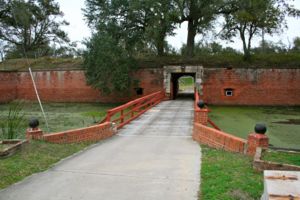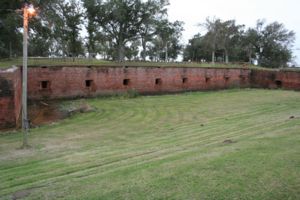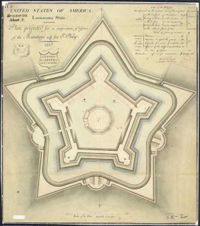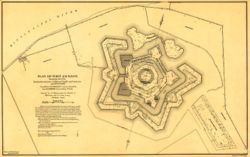Fort Jackson (2): Difference between revisions
John Stanton (talk | contribs) No edit summary |
John Stanton (talk | contribs) No edit summary |
||
| Line 1: | Line 1: | ||
{{SocialNetworks}} | {{SocialNetworks}} | ||
'''{{PAGENAME}}''' (1832-1922) - A [[Third System]] Coastal Fort first established in 1832 on the Mississippi River at Plaguemines Bend. Named after Gen. [[Andrew Jackson]],seventh President of the United States. Abandoned in 1922. | '''{{PAGENAME}}''' (1832-1922) - A [[Third System]] Coastal Fort first established in 1832 on the Mississippi River at Plaguemines Bend, Plaquemines Parish, Louisiana. Named after Gen. [[Andrew Jackson]],seventh President of the United States. Abandoned in 1922. | ||
{{Clr}} | {{Clr}} | ||
[[Image:Fort Jackson - 02.jpg|300px|thumb|left|Fort Jackson Sallyport]] | [[Image:Fort Jackson - 02.jpg|300px|thumb|left|Fort Jackson Sallyport]] | ||
| Line 11: | Line 11: | ||
Construction of the [[Third System]] fort began in 1822 and was completed in 1832 at a cost of $ 554,500. The fort was built on a foundation of three layers of cypress logs topped by cypress 2x4s submerged underwater. The fort walls are of red brick, twenty five feet high, twenty feet thick, with granite reinforced gun foundations. The fort layout is in the shape of a regular pentagon with arrow shaped bastions on each point. In the center was a 10 sided open center citadel that would reportedly house 500 troops. By the [[U.S. Civil War]] a separate water battery had been built on the right flank of the fort. | Construction of the [[Third System]] fort began in 1822 and was completed in 1832 at a cost of $ 554,500. The fort was built on a foundation of three layers of cypress logs topped by cypress 2x4s submerged underwater. The fort walls are of red brick, twenty five feet high, twenty feet thick, with granite reinforced gun foundations. The fort layout is in the shape of a regular pentagon with arrow shaped bastions on each point. In the center was a 10 sided open center citadel that would reportedly house 500 troops. By the [[U.S. Civil War]] a separate water battery had been built on the right flank of the fort. | ||
{{Clr}} | {{Clr}} | ||
== [[U.S. Civil War]] == | == [[U.S. Civil War]] (1861-1865) == | ||
[[Image:FortJacksonAfterBattleMap.jpg|thumb|left|250px|After 1862 Battle Map Showing Battle Damage]] | [[Image:FortJacksonAfterBattleMap.jpg|thumb|left|250px|After 1862 Battle Map Showing Battle Damage]] | ||
{{PlaqueminesBend}} | {{PlaqueminesBend}} | ||
== [[Endicott Period]] == | == [[Endicott Period]] (1890-1910) == | ||
{{Clr}} | {{Clr}} | ||
{{FtJacksonEndicott}} | {{FtJacksonEndicott}} | ||
[[Image:Fort Jackson Plan.jpg|thumb|left|795px|Fort Jackson Plan]] | [[Image:Fort Jackson Plan.jpg|thumb|left|795px|Fort Jackson Plan]] | ||
{{Clr}} | {{Clr}} | ||
== [[World War I]] == | == [[World War I]] (1917-1918) == | ||
Fort Jackson was used as a training base during [[World War I]]. Abandoned in 1922, the Fort was declared surplus in 1927 and was purchased by a New Orleans couple, they donated it to Plauemines Parish in 1962 and it is still owned by the Parish. In 1960 [[Fort Jackson]] and [[Fort St. Philip]] were designated National Historic Landmarks. | Fort Jackson was used as a training base during [[World War I]]. Abandoned in 1922, the Fort was declared surplus in 1927 and was purchased by a New Orleans couple, they donated it to Plauemines Parish in 1962 and it is still owned by the Parish. In 1960 [[Fort Jackson]] and [[Fort St. Philip]] were designated National Historic Landmarks. | ||
== Current Status == | == Current Status == | ||
| Line 34: | Line 34: | ||
</googlemap> | </googlemap> | ||
|valign="top"| | |valign="top"| | ||
'''Location:''' Fort Jackson Park, Louisiana. | '''Location:''' Fort Jackson Park, Plaquemines Parish, Louisiana. | ||
{{Mapit-US-cityscale|29.356668|-89.455447}} | {{Mapit-US-cityscale|29.356668|-89.455447}} | ||
| Line 42: | Line 42: | ||
'''Sources:''' | '''Sources:''' | ||
* {{Roberts}}, page 339-341 | * {{Roberts}}, page 339-341 | ||
* {{ | * {{Weaver}}, page 179-196 | ||
'''Links:''' | |||
* [http://www.northamericanforts.com/East/ladelta.html#new North American Forts - Fort Jackson] | |||
* {{CDSGMainLink}} | |||
{{Visited|9 Dec 2009}} | {{Visited|9 Dec 2009}} | ||
| Line 58: | Line 62: | ||
Image:Fort Jackson - 29.jpg|Fort Jackson Water Battery Magazine Roof | Image:Fort Jackson - 29.jpg|Fort Jackson Water Battery Magazine Roof | ||
Image:Fort Jackson - 37.jpg|Fort Jackson Outer Gun Line | Image:Fort Jackson - 37.jpg|Fort Jackson Outer Gun Line | ||
Image:Ft jackson4.jpg|Caption here) | Image:Ft jackson4.jpg|(Caption here) | ||
Image:Ft jackson3.jpg|Caption here) | Image:Ft jackson3.jpg|(Caption here) | ||
Image:Ft Jackson2.jpg|Caption here) | Image:Ft Jackson2.jpg|(Caption here) | ||
Image:Ft jackson1.jpg|Caption here) | Image:Ft jackson1.jpg|(Caption here) | ||
</gallery> | </gallery> | ||
| Line 76: | Line 80: | ||
[[Category:U.S. Civil War Forts]] | [[Category:U.S. Civil War Forts]] | ||
[[Category:National Historic Landmark]] | [[Category:National Historic Landmark]] | ||
[[Category:Louisiana Plaquemines Parish]] | |||
[[Category:Harbor Defense of the Mississippi]] | [[Category:Harbor Defense of the Mississippi]] | ||
[[Category:{{PAGENAME}}]] | [[Category:{{PAGENAME}}]] | ||
[[Category:Preserved]] | [[Category:Preserved]] | ||
[[Category:2009 Southern Trip]] | [[Category:2009 Southern Trip]] | ||
Revision as of 18:37, 20 May 2011
Fort Jackson (2) (1832-1922) - A Third System Coastal Fort first established in 1832 on the Mississippi River at Plaguemines Bend, Plaquemines Parish, Louisiana. Named after Gen. Andrew Jackson,seventh President of the United States. Abandoned in 1922.


Fort Jackson (2) History
Established as a part of the Harbor Defense of the Mississippi defending Plaguemines Bend on the Mississippi River.
Third System

Construction of the Third System fort began in 1822 and was completed in 1832 at a cost of $ 554,500. The fort was built on a foundation of three layers of cypress logs topped by cypress 2x4s submerged underwater. The fort walls are of red brick, twenty five feet high, twenty feet thick, with granite reinforced gun foundations. The fort layout is in the shape of a regular pentagon with arrow shaped bastions on each point. In the center was a 10 sided open center citadel that would reportedly house 500 troops. By the U.S. Civil War a separate water battery had been built on the right flank of the fort.
U.S. Civil War (1861-1865)

On 8 Jan 1861, just before the start of the U.S. Civil War, Fort Jackson and Fort St. Philip were seized from their Federal garrisons by Louisiana forces. Louisiana troops occupied both Fort St. Philip and Fort Jackson until an epic battle with Union Admiral David Farragut's fleet of gunboats in April 1862 at Plaquemines Bend. Farragut's mission was to seize control of the Mississippi and split the Confederacy in two. In April 1862 Farragut's fleet engaged both forts and attempted to destroy them with a six-day bombardment. The bombardment failed to destroy the forts and Farragut was forced to make a run past both forts with 17 wooden ships at 2 AM on 24 Apr 1862. In the ensuing Battle of Forts Jackson and St. Philip, 13 of the ships made it past the forts, and Farragut went on to New Orleans which surrendered to him on 29 Apr 1862. Both forts gave a good account of themselves and in the end it was probably the lack of enough cannon that enabled the fleet to get by. Fort Jackson was designed for 93 gun emplacements but had only 69 guns emplaced while Fort St. Philip had only 45 guns. The Union gunboats were able to send a total of 8,100 rounds against both forts. Both forts were surrendered to Union forces on 28 Apr 1862 and then garrisoned by them until the end of the war.
Endicott Period (1890-1910)
| Battery Click on Battery links below |
No. | Caliber | Type Mount | Service Years | Battery Cost | Notes |
|---|---|---|---|---|---|---|
| Battery Ransom | 2 | 8" | Disappearing | 1898-1899-1899-1918 | $ 150,000 | |
| Battery Millar | 2 | 3" | Balanced Pillar | 1899-1900-1901-1920 | $ 22,868 | |
| Source: CDSG | ||||||

World War I (1917-1918)
Fort Jackson was used as a training base during World War I. Abandoned in 1922, the Fort was declared surplus in 1927 and was purchased by a New Orleans couple, they donated it to Plauemines Parish in 1962 and it is still owned by the Parish. In 1960 Fort Jackson and Fort St. Philip were designated National Historic Landmarks.
Current Status
The old fort is still closed to the public after being damaged by Hurricane Katrina and Rita. No period guns or carriages in place.
|
{"selectable":false,"width":"500"} |
Location: Fort Jackson Park, Plaquemines Parish, Louisiana. Maps & Images Lat: 29.356668 Long: -89.455447 |
Sources:
- Roberts, Robert B., Encyclopedia of Historic Forts: The Military, Pioneer, and Trading Posts of the United States, Macmillan, New York, 1988, 10th printing, ISBN 0-02-926880-X, page 339-341
- Weaver, John R. II, A Legacy in Brick and Stone: America Coastal Defense Forts of the Third System, Redoubt Press, McLean, 2001, First Printing, ISBN 1-57510-069-X, page 179-196
Links:
Visited: 9 Dec 2009
Fort Jackson (2) Picture Gallery
|
Click on the picture to see a larger version. Contribute additional pictures - the more the better! |
-
Fort Jackson Entrance
-
Fort Jackson Ditch
-
Fort Jackson Wall
-
Fort Jackson Gun Mount
-
Fort Jackson Bastion
-
Fort Jackson Water Battery
-
Fort Jackson Water Battery Magazine
-
Fort Jackson Water Battery Magazine Roof
-
Fort Jackson Outer Gun Line
-
(Caption here)
-
(Caption here)
-
(Caption here)
-
(Caption here)












